Wind Forces and Flow Patterns of Three Tandem Prisms with a Small Height–Width Ratio
Abstract
:1. Introduction
2. Outline of Wind Tunnel Tests and Numerical Simulations
2.1. Pressure Measurements by Wind Tunnel Tests
2.2. Large Eddy Simulations Setup
3. Results and Discussions
3.1. Wind Pressure Coefficients on the Isolated Prism
3.2. Dependency of Wind Force Coefficients on Prism Spacing
3.3. Wind Pressure Time Histories on Three Tandem Prisms
3.4. Wind Flow among Three Tandem Prisms
4. Conclusions
Author Contributions
Funding
Institutional Review Board Statement
Informed Consent Statement
Data Availability Statement
Acknowledgments
Conflicts of Interest
Appendix A
| Wind Force | Spacing Ratio (S/W) | |||||||||||||||
|---|---|---|---|---|---|---|---|---|---|---|---|---|---|---|---|---|
| 0.2 | 0.4 | 0.5 | 0.6 | 0.7 | 0.8 | 1 | 1.2 | 1.4 | 1.6 | 2 | 2.4 | 2.8 | 3.2 | 4 | 4.8 | |
| Mean CD | 0.662 | 0.692 | 0.678 | 0.698 | 0.664 | 0.721 | 0.650 | 0.668 | 0.667 | 0.705 | 0.701 | 0.700 | 0.705 | 0.710 | 0.752 | 0.693 |
| Mean CRL | 0.354 | 0.331 | 0.342 | 0.327 | 0.317 | 0.300 | 0.301 | 0.332 | 0.308 | 0.334 | 0.337 | 0.312 | 0.316 | 0.310 | 0.303 | 0.321 |
| Mean CLL | 0.008 | 0.001 | 0.015 | 0.060 | 0.080 | 0.052 | 0.002 | 0.010 | 0.006 | 0.010 | 0.009 | 0.000 | 0.007 | 0.009 | 0.008 | 0.003 |
| RMS CD | 0.148 | 0.149 | 0.147 | 0.150 | 0.152 | 0.153 | 0.150 | 0.153 | 0.152 | 0.150 | 0.155 | 0.163 | 0.162 | 0.160 | 0.159 | 0.159 |
| RMS CRL | 0.055 | 0.049 | 0.050 | 0.050 | 0.052 | 0.054 | 0.049 | 0.054 | 0.055 | 0.054 | 0.053 | 0.051 | 0.052 | 0.061 | 0.057 | 0.069 |
| RMS CLL | 0.071 | 0.072 | 0.090 | 0.112 | 0.075 | 0.080 | 0.067 | 0.067 | 0.067 | 0.067 | 0.068 | 0.073 | 0.079 | 0.071 | 0.088 | 0.084 |
| Wind Force | Spacing Ratio (S/W) | |||||||||||||||
|---|---|---|---|---|---|---|---|---|---|---|---|---|---|---|---|---|
| 0.2 | 0.4 | 0.5 | 0.6 | 0.7 | 0.8 | 1 | 1.2 | 1.4 | 1.6 | 2 | 2.4 | 2.8 | 3.2 | 4 | 4.8 | |
| Mean CD | 0.057 | 0.094 | 0.146 | 0.307 | 0.386 | 0.292 | 0.257 | 0.278 | 0.315 | 0.374 | 0.444 | 0.496 | 0.518 | 0.616 | 0.646 | 0.644 |
| Mean CRL | 0.090 | 0.059 | 0.087 | 0.074 | 0.120 | 0.067 | 0.073 | 0.089 | 0.105 | 0.155 | 0.187 | 0.222 | 0.241 | 0.307 | 0.326 | 0.328 |
| Mean CLL | 0.015 | 0.017 | 0.031 | 0.066 | 0.108 | 0.049 | 0.026 | 0.001 | 0.001 | 0.008 | 0.009 | 0.006 | 0.009 | 0.001 | 0.008 | 0.001 |
| RMS CD | 0.050 | 0.063 | 0.079 | 0.112 | 0.122 | 0.112 | 0.095 | 0.094 | 0.102 | 0.103 | 0.102 | 0.112 | 0.116 | 0.126 | 0.136 | 0.125 |
| RMS CRL | 0.040 | 0.042 | 0.043 | 0.049 | 0.057 | 0.050 | 0.051 | 0.049 | 0.053 | 0.053 | 0.054 | 0.056 | 0.057 | 0.059 | 0.061 | 0.063 |
| RMS CLL | 0.045 | 0.047 | 0.090 | 0.103 | 0.112 | 0.097 | 0.074 | 0.064 | 0.071 | 0.068 | 0.065 | 0.067 | 0.068 | 0.062 | 0.067 | 0.059 |
| Wind Force | Spacing Ratio (S/W) | |||||||||||||||
|---|---|---|---|---|---|---|---|---|---|---|---|---|---|---|---|---|
| 0.2 | 0.4 | 0.5 | 0.6 | 0.7 | 0.8 | 1 | 1.2 | 1.4 | 1.6 | 2 | 2.4 | 2.8 | 3.2 | 4 | 4.8 | |
| Mean CD | 0.135 | 0.166 | 0.214 | 0.325 | 0.473 | 0.342 | 0.371 | 0.383 | 0.419 | 0.456 | 0.494 | 0.521 | 0.525 | 0.588 | 0.614 | 0.590 |
| Mean CRL | 0.075 | 0.035 | 0.080 | 0.057 | 0.137 | 0.080 | 0.079 | 0.085 | 0.094 | 0.106 | 0.144 | 0.180 | 0.177 | 0.272 | 0.285 | 0.285 |
| Mean CLL | 0.011 | 0.012 | 0.018 | 0.051 | 0.098 | 0.055 | 0.037 | 0.023 | 0.021 | 0.008 | 0.006 | 0.002 | 0.000 | 0.024 | 0.001 | 0.019 |
| RMS CD | 0.041 | 0.047 | 0.060 | 0.096 | 0.113 | 0.089 | 0.087 | 0.088 | 0.090 | 0.095 | 0.100 | 0.106 | 0.104 | 0.120 | 0.130 | 0.123 |
| RMS CRL | 0.039 | 0.038 | 0.040 | 0.043 | 0.058 | 0.053 | 0.048 | 0.043 | 0.045 | 0.051 | 0.052 | 0.056 | 0.051 | 0.052 | 0.059 | 0.061 |
| RMS CLL | 0.049 | 0.054 | 0.095 | 0.105 | 0.116 | 0.083 | 0.066 | 0.061 | 0.057 | 0.062 | 0.067 | 0.069 | 0.070 | 0.071 | 0.077 | 0.068 |
References
- Sakamoto, H.; Hainu, H.; Obata, Y. Fluctuating forces acting on two square prisms in a tandem arrangement. J. Wind Eng. Ind. Aerodyn. 1987, 26, 85–103. [Google Scholar] [CrossRef]
- Sakamoto, H.; Haniu, H. Aerodynamic forces acting on two square prisms placed vertically in a turbulent boundary layer. J. Wind Eng. Ind. Aerodyn. 1988, 31, 41–66. [Google Scholar] [CrossRef]
- Sakamoto, H.; Haniu, H. Effect of free-stream turbulence on characteristics of fluctuating forces acting on two square prisms in tandem arrangement. J. Fluids Eng. 1988, 110, 140–146. [Google Scholar] [CrossRef]
- Liu, C.H.; Chen, J.M. Observations of hysteresis in flow around two square cylinders in a tandem arrangement. J. Wind Eng. Ind. Aerodyn. 2002, 90, 1019–1050. [Google Scholar] [CrossRef]
- Kim, M.K.; Dong, K.K.; Yoon, S.H.; Lee, D.H. Measurements of the flow fields around two square cylinders in a tandem arrangement. J. Mech. Sci. Technol. 2008, 22, 397. [Google Scholar] [CrossRef]
- Sohankar, A. A LES study of the flow interference between tandem square cylinder pairs. Theor. Comput. Fluid Dyn. 2014, 28, 531–548. [Google Scholar] [CrossRef]
- Sharma, A.; Mittal, H.; Gairola, A. Detached-eddy simulation of interference between buildings in tandem arrangement. J. Build. Eng. 2019, 21, 129–140. [Google Scholar] [CrossRef]
- Li, X.X.; Liu, C.H.; Leung, D. Numerical investigation of pollutant transport characteristics inside deep urban street canyons. Atmos. Environ. 2009, 43, 2410–2418. [Google Scholar] [CrossRef]
- Sohankar, A. A numerical investigation of the flow over a pair of identical square cylinders in a tandem arrangement. Int. J. Numer. Methods Fluids 2012, 70, 1244–1257. [Google Scholar] [CrossRef]
- Chand, I.; Sharma, V.K.; Bhargava, P.K. Effect of neighbouring buildings on mean wind pressure distribution on a flat roof. Arch. Sci. Rev. 1995, 38, 29–36. [Google Scholar] [CrossRef]
- Chen, B.; Cheng, H.; Kong, H.; Chen, X.; Yang, Q. Interference effects on wind loads of gable-roof buildings with different roof slopes. J. Wind Eng. Ind. Aerodyn. 2019, 189, 198–217. [Google Scholar] [CrossRef]
- Lee, B.E.; Soliman, B.F. An investigation of the forces on three dimensional bluff bodies in rough wall turbulent boundary layers. J. Fluids Eng. 1977, 99, 503–509. [Google Scholar] [CrossRef]
- Hussain, M.; Lee, B.E. A wind tunnel study of the mean pressure forces acting on large groups of low-rise buildings. J. Wind Eng. Ind. Aerodyn. 1980, 6, 207–225. [Google Scholar] [CrossRef]
- Khanduri, A.C.; Stathopoulos, T.; Bédard, C. Wind-induced interference effects on buildings—A review of the state-of-the-art. Eng. Struct. 1998, 20, 617–630. [Google Scholar] [CrossRef]
- Load Code for the Design of Building Structures: GB 50009—2012; China Architecture & Building Press: Beijing, China, 2012. (In Chinese)
- Chen, B.; Luo, P.Y.; Yang, Q.S. Frequency response function of a pressure measurement pipe system and its effect on structural wind effects. J. Vib. Shock 2014, 33, 130–134. (In Chinese) [Google Scholar] [CrossRef]
- Tominaga, Y.; Mochida, A.; Yoshie, R.; Kataoka, H.; Nozu, T.; Yoshikawa, M.; Shirasawa, T. AIJ guidelines for practical applications of CFD to pedestrian wind environment around buildings. J. Wind Eng. Ind. Aerodyn. 2008, 96, 1749–1761. [Google Scholar] [CrossRef]
- Liu, J.; Niu, J.; Du, Y.; Ming, C. Les for pedestrian level wind around an idealized building array—Assessment of sensitivity to influencing parameters. Sustain. Cities Soc. 2019, 44, 406–415. [Google Scholar] [CrossRef]
- Liu, J.L.; Niu, J.L.; Du, Y.X.; Mak, C.M.; Zhang, Y.F. An investigation on external airflow around low-rise building with various roof types: PIV measurements and LES simulations. Build. Environ. 2020, 169, 106583. [Google Scholar] [CrossRef]
- Wang, J.; Phuc, P.V.; Yang, Q.; Tamura, Y. Les study of wind pressure and flow characteristics of flat-roof-mounted solar arrays. J. Wind Eng. Ind. Aerodyn. 2020, 198, 104096. [Google Scholar] [CrossRef]
- Stathopoulos, T.; Dumitrescu-Brulotte, M. Design recommendations for wind loading on buildings of intermediate height. Can. J. Civ. Eng. 1989, 16, 910–916. [Google Scholar] [CrossRef]
- Lu, P.C.; Cheng, C.M.; Cheng, C.W. Aerodynamic forces on two stationary and oscillating square prisms in tandem and side by side arrangements. J. Chin. Inst. Eng. 1998, 21, 535–546. [Google Scholar] [CrossRef]
- Hunter, L.J.; Watson, I.D.; Johnson, G.T. Modelling air flow regimes in urban canyons. Energy Build. 1990, 15, 315–324. [Google Scholar] [CrossRef]
- Zhang, W.; Yang, H.; Dou, H.S.; Zhu, Z.C. Forced convection of flow past two tandem rectangular cylinders in a channel. Numer. Heat Transf. Part A 2017, 2, 89–106. [Google Scholar] [CrossRef]
- Hosseini, N.; Griffith, M.D.; Leontini, J.S. The flow past large numbers of cylinders in tandem. J. Fluid Struct. 2020, 98, 103103. [Google Scholar] [CrossRef]
- Krajnović, S.; Davidson, L. Large-eddy simulation of the flow around a bluff body. AIAA J. 2002, 40, 927–936. [Google Scholar] [CrossRef] [Green Version]
- Hunter, L.J.; Johnson, G.T.; Watson, I.D. An investigation of three-dimensional characteristics of flow regimes within the urban canyon. Atmos. Environ. 1992, 26, 425–432. [Google Scholar] [CrossRef]
- Paik, J.; Sotiropoulos, F.; Porte-Agel, F. Detached eddy simulation of flow around two wall-mounted cubes in tandem. Int. J. Heat Fluid Flow 2009, 30, 286–305. [Google Scholar] [CrossRef]
- Rostamy, N. Fundamental Studies of the Wake Structure for Surface-Mounted Finite-Height Cylinders and Prisms. Ph.D. Thesis, University of Saskatchewan, Saskatoon, SK, Canada, 2012. Available online: http://hdl.handle.net/10388/ETD-2012-09-644 (accessed on 18 June 2021).
- Khorrami, M.R.; Choudhari, M.M.; Lockard, D.P.; Jenkins, L.N.; Mcginley, C.B. Unsteady flowfield around tandem cylinders as prototype component interaction in airframe noise. AIAA J. 2005, 45, 1930–1941. [Google Scholar] [CrossRef] [Green Version]
- Schulman, L.L.; Strimaitis, D.G.; Scire, J.S. Development and evaluation of the prime plume rise and building downwash model. J. Air Waste Manag. Assoc. 2000, 50, 378–390. [Google Scholar] [CrossRef] [Green Version]
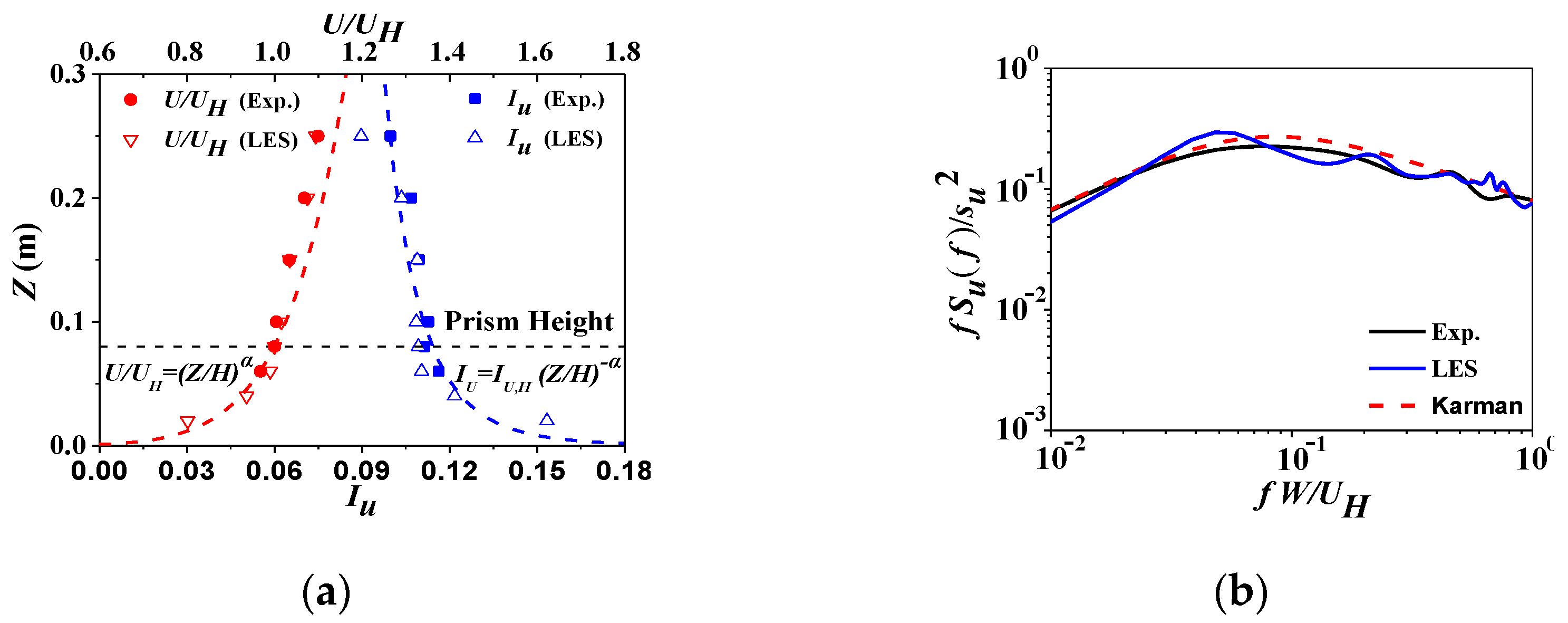



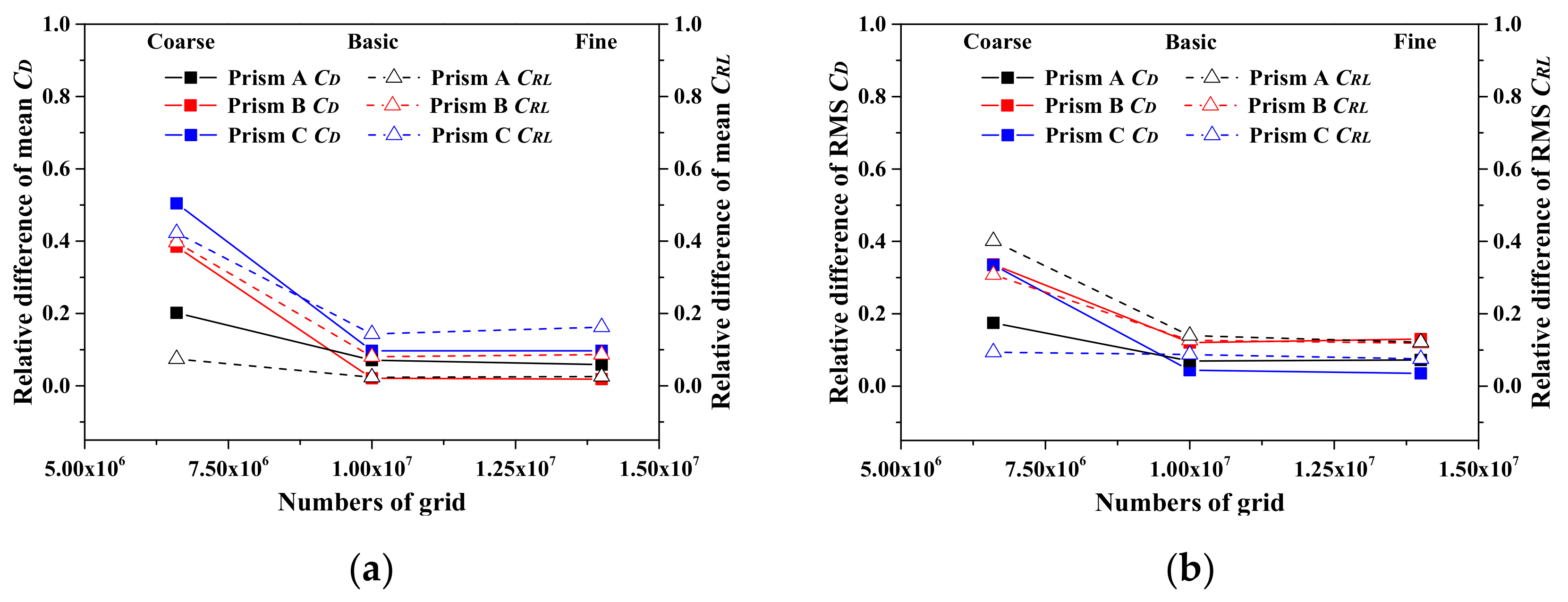
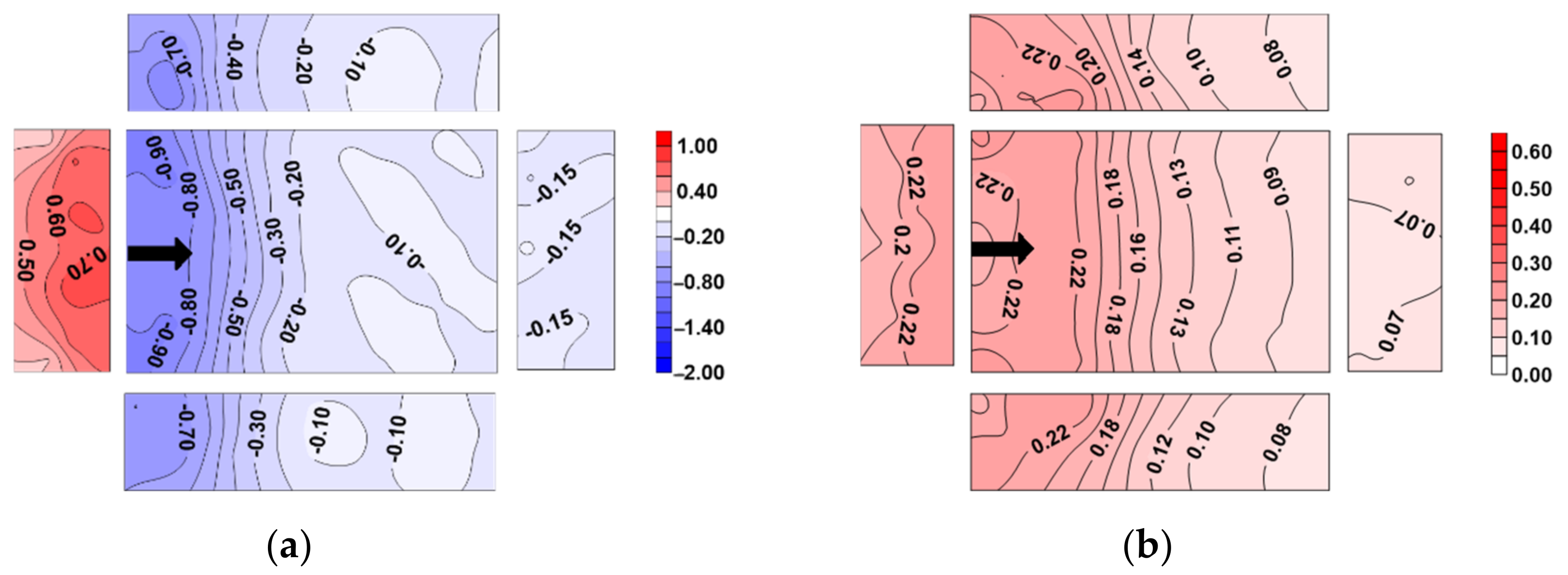

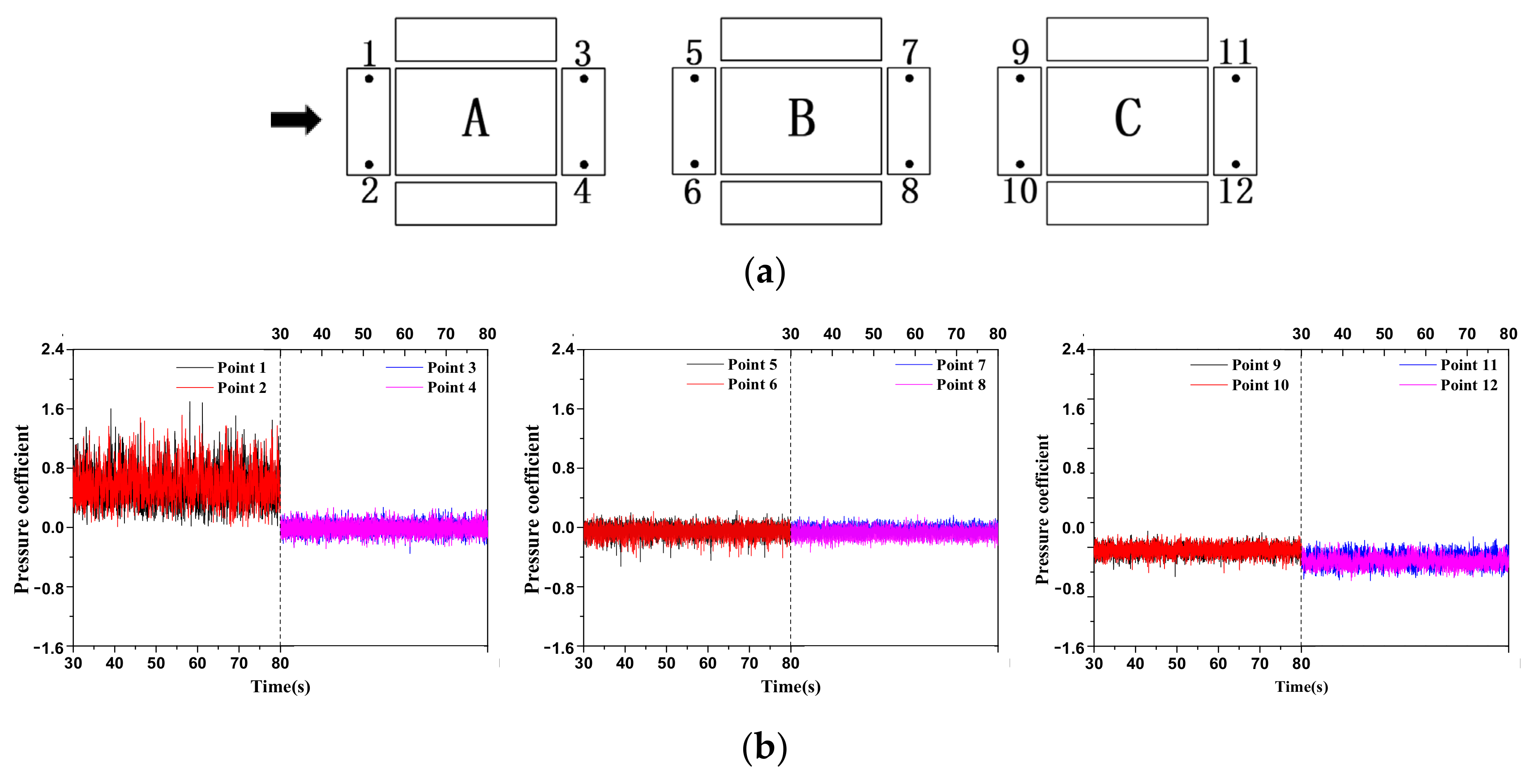


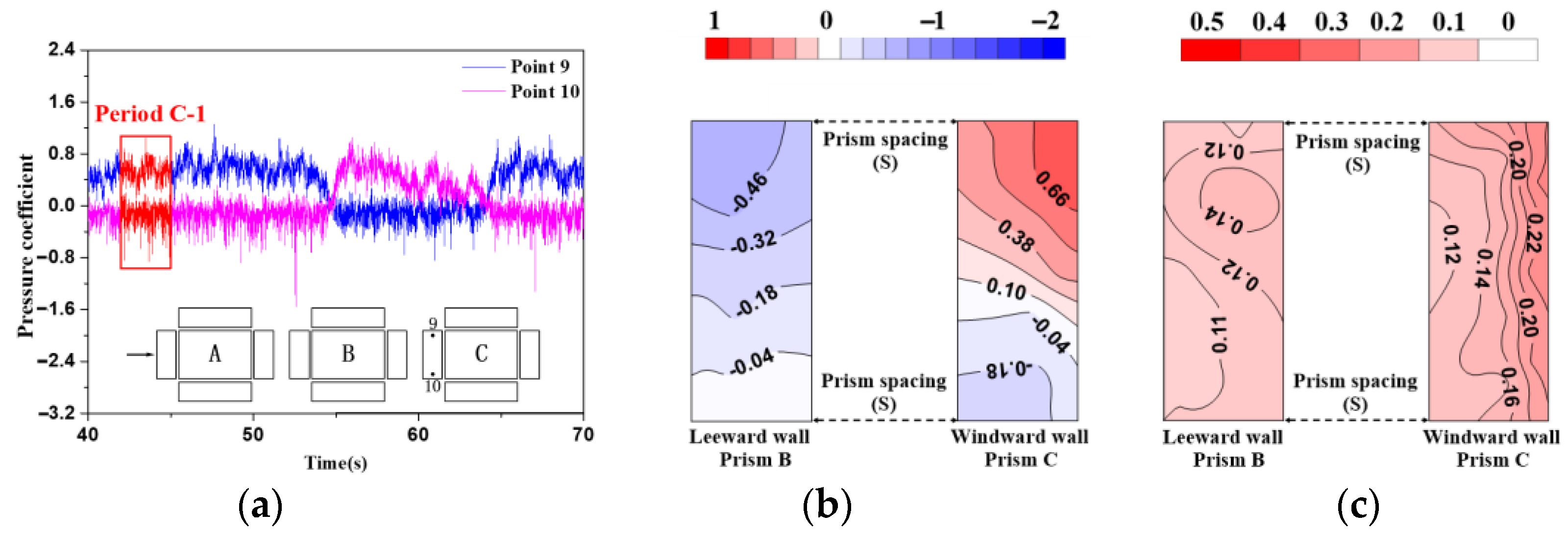
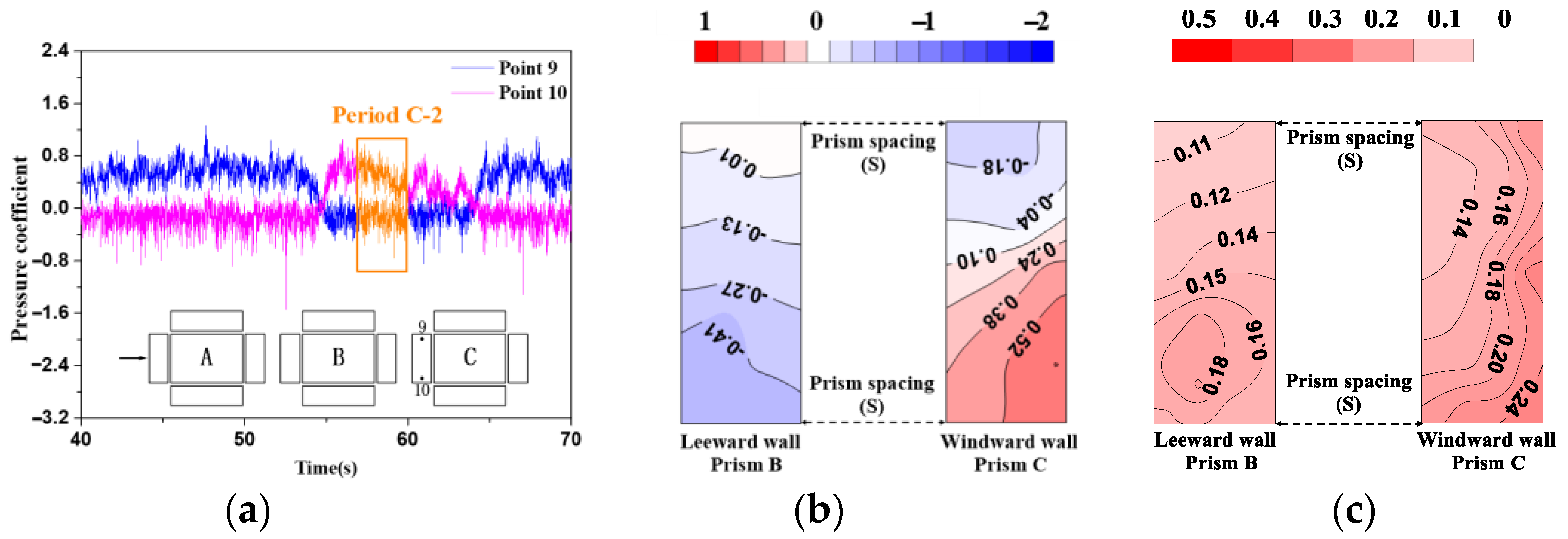

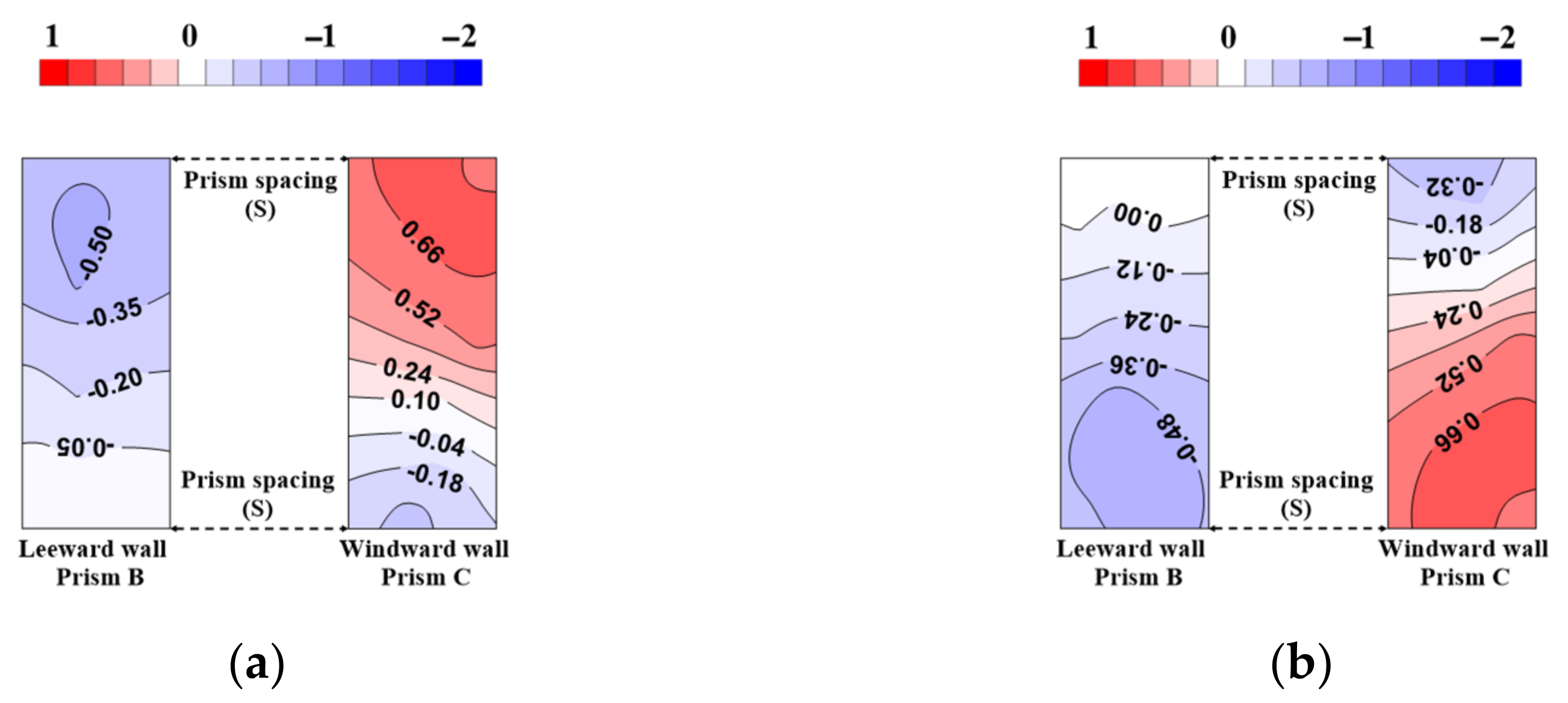
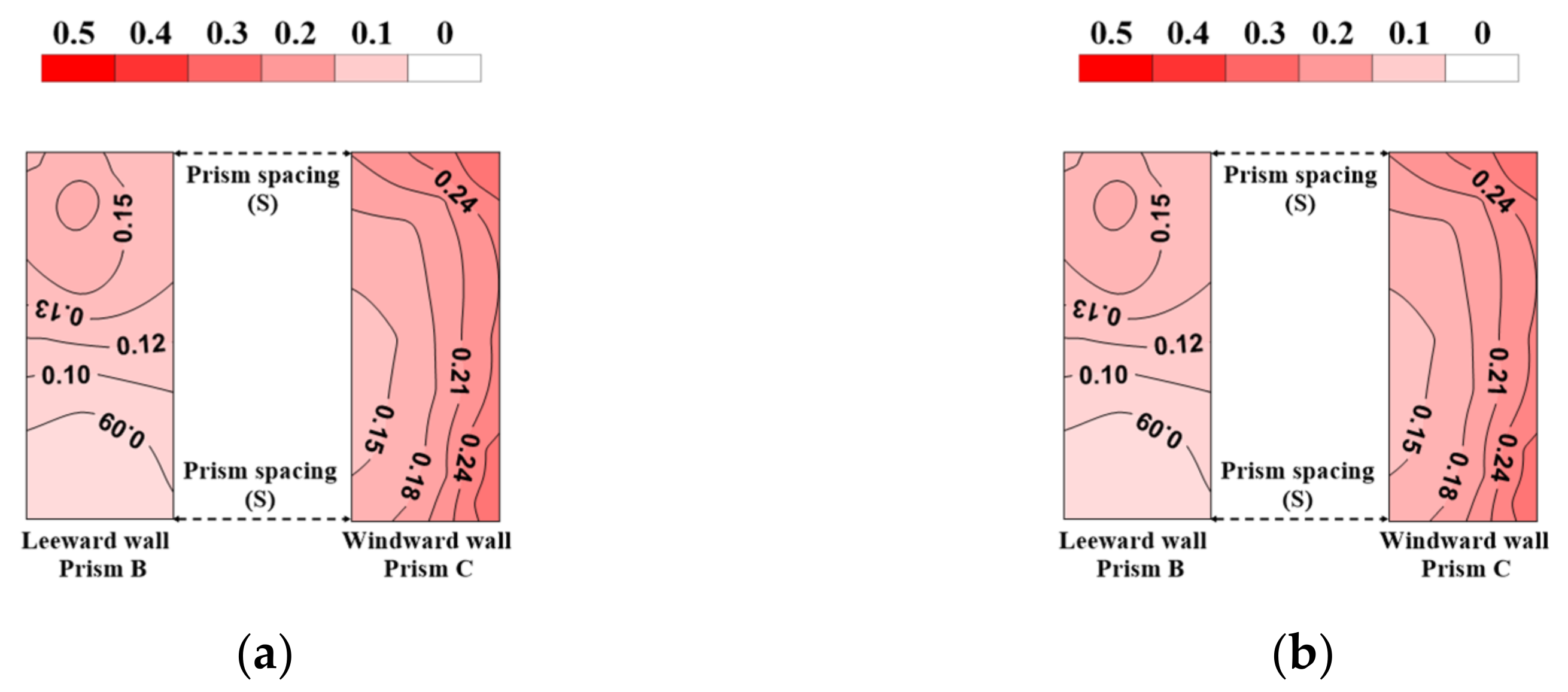

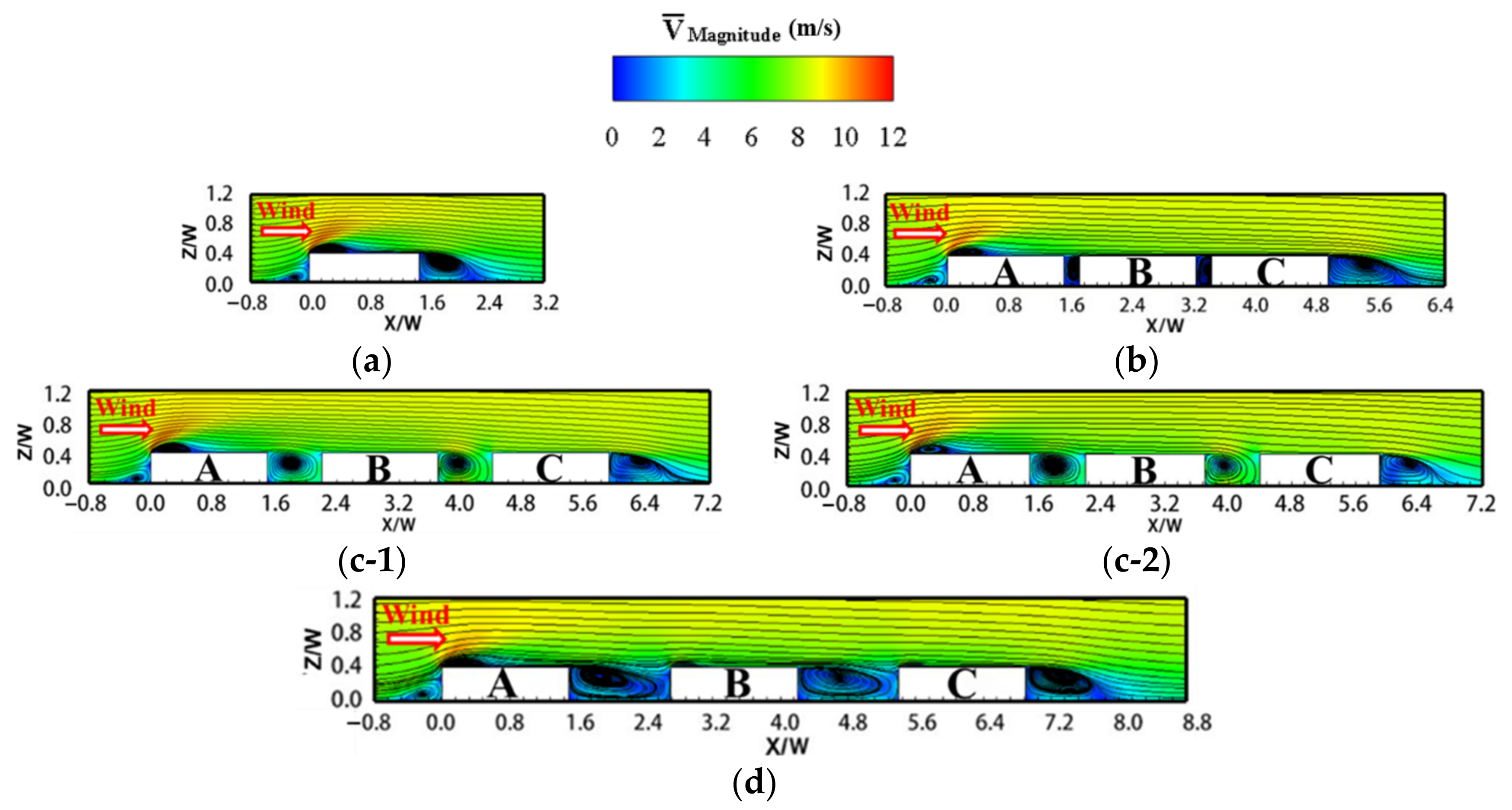
| Mean CD | RMS CD | Mean CLL | RMS CLL | Mean CRL | RMS CRL |
|---|---|---|---|---|---|
| 0.73 | 0.14 | 0.01 | 0.07 | 0.35 | 0.06 |
Publisher’s Note: MDPI stays neutral with regard to jurisdictional claims in published maps and institutional affiliations. |
© 2022 by the authors. Licensee MDPI, Basel, Switzerland. This article is an open access article distributed under the terms and conditions of the Creative Commons Attribution (CC BY) license (https://creativecommons.org/licenses/by/4.0/).
Share and Cite
Du, K.; Chen, B. Wind Forces and Flow Patterns of Three Tandem Prisms with a Small Height–Width Ratio. Appl. Sci. 2022, 12, 2254. https://doi.org/10.3390/app12042254
Du K, Chen B. Wind Forces and Flow Patterns of Three Tandem Prisms with a Small Height–Width Ratio. Applied Sciences. 2022; 12(4):2254. https://doi.org/10.3390/app12042254
Chicago/Turabian StyleDu, Kun, and Bo Chen. 2022. "Wind Forces and Flow Patterns of Three Tandem Prisms with a Small Height–Width Ratio" Applied Sciences 12, no. 4: 2254. https://doi.org/10.3390/app12042254
APA StyleDu, K., & Chen, B. (2022). Wind Forces and Flow Patterns of Three Tandem Prisms with a Small Height–Width Ratio. Applied Sciences, 12(4), 2254. https://doi.org/10.3390/app12042254






